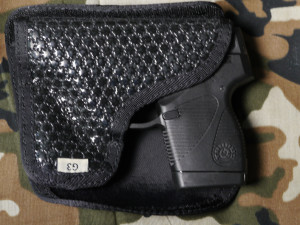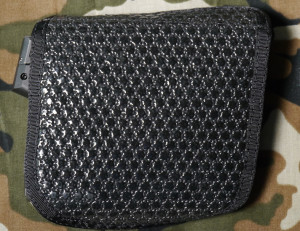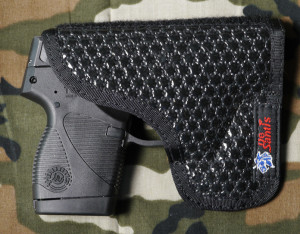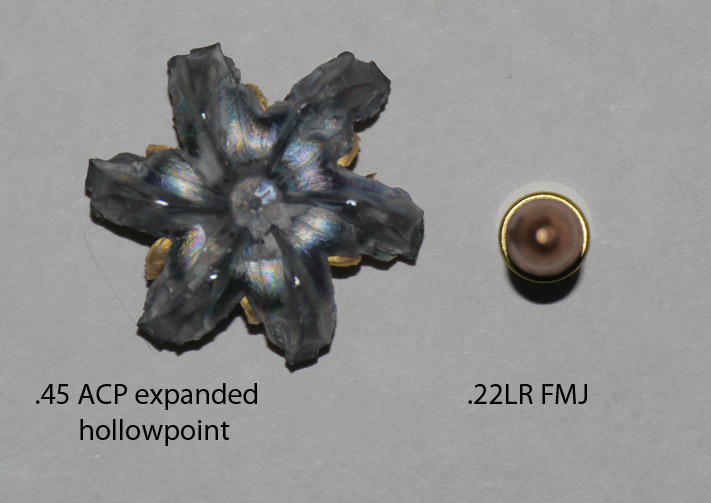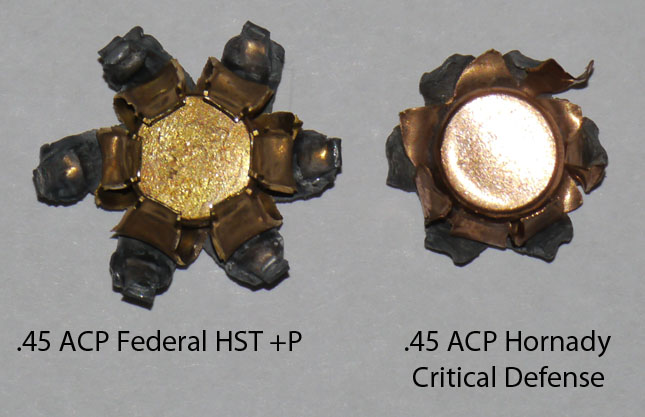In my ongoing quest to find the ideally suitable .380 round for a Taurus TCP, I’ve specified that I’d like the ammo to be able to meet the minimum 12″ penetration as specified by the FBI’s ammo testing protocol.
Needless to say, that’s generated some comments from various people, who want to know: Why? Questions such as “Why do you need 12 inches? The average bad guy isn’t even 12″ thick.” Or “Why do you need to follow the FBI protocol — you’re not the FBI.” Or “I don’t fancy myself some SWAT agent, so I don’t care what the FBI protocol is…”
Truth be told, I understand where they’re all coming from. The most recent question was a simple one, in relation to one of my videos showing that the ammo would barely penetrate 10″, a person asked “why is 10 inches bad?” I went on a writing rampage to try to explain it, and figured that instead of being buried as a forum post, it might make a decent article for the blog here.
Accordingly, here is what I might call…
A Beginner’s Guide to Ballistic Gel Testing Standards
In reference to the question “why is 10 inches of bullet penetration bad?” — It’s not that 10 inches is “bad” — in fact, I’d dare say that a lot of folks would be content with 10 inches, and that a bullet that penetrates 10″ of ballistic gel may possibly be an effective manstopper, under the right conditions.
But don’t confuse 10″ of gel penetration with 10 inches of torso thickness — they’re not intended to be the same thing!
Here’s the thing — some of the best minds in the business got together to evaluate handgun performance and come up with some standards that would result in repeatable, predictable, effective ammo performance. A disastrous shootout in Miami resulted in calls to find out what went wrong, and how to prevent it occurring again. The results are published in the FBI report “Handgun Wounding Factors and Effectiveness”. You can read the entire report at www.firearmstactical.com, just google “Handgun Wounding Factors and Effectiveness“.
What is Ballistics Gelatin?
Ballistics gel is designed to mimic the properties of human tissue, and a bullet’s penetration in ballistics gel should be comparable to how the bullet would have penetrated through muscle tissue in a human being. Ballistics gel is made from boiled-up animal tissue (hide, ligaments, tendons, etc) that is then distilled down to a powder (gelatin powder) and then mixed at a precise ratio and under precise conditions to result in a product (ballistic gel) that mimics the properties of flesh (to such forces as resistance, shear, stress, and tearing). Mainly because it is flesh, just boiled and mixed together to make one big homogenous block. It’s not exactly the same thing as flesh (you can easily tear off a chunk, for example) but as far as its response to a bullet, it is an excellent and highly accurate simulant. It has been extensively correlated against actual shootings and wound examinations of trauma victims, and the penetration and expansion characteristics have been verified as being quite accurate to actual trauma wounds.
As said before, ballistics gel provides a tissue simulant that is homogenous (all consistent, all the same). But humans aren’t homogenous. We’re made of all sorts of different densities — lungs are basically empty, bones are comparatively dense, then there are super-stretchy tissues like intestines and not-stretchy tissues like the liver… we’re not homogenous. So ballistic gel isn’t designed to exactly mimic the human BODY, it’s designed to mimic a relatively homogenous tissue such as muscle tissue.
“I’ve never been attacked by a block of Jell-O”…
I hear this a lot, from people who just don’t seem to understand — shooting into ballistic gel isn’t designed to mimic shooting into a human body. Shooting into ballistic gel is designed to create a repeatable, standardized testing method that replicates the average performance of a bullet through a body, but does so in a way that is predictable, controlled, repeatable and directly comparable. Because shooting into a body is one of the most unpredictable things we can do. There are so many variables, it’s nearly impossible to account for them all! Whether a bullet tumbles or not, whether it expands or not, whether it strikes a bone or not, whether it strikes that bone head-on and passes right through, or it strikes the side of a rib and is deflected; whether it strikes a critical organ or whether it sails straight through without hitting anything vital, whether it cuts an artery or only passes through a lung, and on and on and on… there’s no way to predict what will happen.
So we don’t try. What we do, is we try to come up with a way of ranking the power of bullets through a homogenous medium of flesh. I know people that get all bent out of shape about “jello shots” because “it’s not a body” but that’s not the point — what it is, is a way of saying “if you shot this bullet into muscle tissue, this is the results you’d get.” And those results have been highly correlated against actual shooting victims. And then you can directly compare the ballistics gel results from one bullet, to what you’d get with another bullet. If one expands more and penetrates deeper, then you can unequivocally say “this bullet would produce more damage in a human body than that one, all other things being equal.”
Why Do I Want My Bullets To Be Capable Of 12″ (or more) Of Penetration?
So here’s a question that people seem to get confused over — does 10″ of ballistic gel penetration mean 10″ of penetration through a chest? Not necessarily. Maybe. Maybe not. It depends on the shot. And it depends on the chest — if our attacker is a 105-pound waif supermodel, who is literally skin and bones, that 10″-gel-penetrating bullet might pass clean through her. If we’re being attacked by a professional bodybuilder with a 52″ chest that’s all muscle, the bullet might stop well short of hitting his vitals. If we’re being attacked by a 350-lb barbecue-and-gravy aficionado with a 52″ chest that’s all fat, the bullet might penetrate further through his chest than it would in the bodybuilder’s, but still stop well short of his vitals. We don’t know what our actual shooting scenario will be, until we’re in it.
But what we DO know, is that if the bullet is able to go through 12″ of ballistic gel, it will also be able to punch through pretty much all of their chests and reach their vitals. And that’s what counts. Think of it as a relative power ranking, because, well, really, that’s what it is — a more powerful bullet could push through more inches of gel. And, accordingly, no matter what tissue it hits in the body, it would be able to push through more of it, than a less-powerful bullet would be able to, if that less-powerful bullet were to have hit in exactly the same spot on a genetically-identical body.
So the penetration question is not about the chest thickness, it’s about however much tissue the bullet can penetrate through, regardless of what type of tissue it encounters (bone, lung, bowel, muscle, fat, etc). The 12″ minimum takes account of factors such as having to shoot through bones, and at odd angles. It’s all already factored in.
And bullet penetration is influenced by a number of design factors — the weight of the bullet, the type of bullet (a solid FMJ or an expanding hollowpoint), the speed of the bullet, the diameter (or caliber) of the bullet; all of these things have a direct influence on how deeply the bullet will penetrate. Which is why we have to test. And why we need a standardized testing medium to test in; one that will deliver consistent and comparable results.
The 12″ penetration figure the FBI arrived at is also a MINIMUM. They would actually prefer to see about 14-15″. The acceptable range for them is 12″ to 18″ of penetration; if it penetrates over 18″ then it would probably exit most bodies and therefore be not as efficient in delivering a wound, and also pose a threat to whatever/whoever is behind the target. If it penetrates less than 12″, then it may not possess enough energy to reach the vital organs and cause an immediate incapacitation of the target.
What Stops An Attacker?
Now, keep in mind — an 8″-penetrating bullet may hurt like hell, it may cause a lot of bleeding, it may make the person who got shot drop their weapon and say “no more!” That all may happen. But it may not. The target may be feeling no pain, they may be on drugs or feeling so much adrenaline that they don’t actually recognize that they’ve been shot, they may continue attacking even after having been shot. That 8″ bullet may actually kill them eventually, too, through aggregated blood loss or through infection or any number of reasons. But when talking about having to shoot in self defense, we’re not trying to kill our attacker, we’re trying to STOP our attacker — immediately. And the only way to force a quick stop is to either hit the central nervous system (brain/upper spine) or damage the circulatory system such that it causes a rapid bleed-out and thus loss of blood pressure, which will deprive the brain of oxygen and cause them to fall unconscious. That’s the goal — stop the attacker from continuing their attack. We’re not trying to “kill” someone, we’re trying to stop them from killing us.
An attacker will stop for several reasons that are completely voluntary: sometimes just seeing a gun in your hand would cause an attacker to stop. Sometimes seeing a gun pointed at them would cause them to stop. Sometimes feeling the pain of a bullet hitting them would cause them to stop immediately. Sometimes they may experience a psychological shock upon being hit, that causes them to drop to the ground. But all of those rely on the attacker WANTING to stop, or choosing to stop. And, frankly, sometimes they don’t want to stop, sometimes they choose not to stop, and you may have to force them to stop. The only way to force them to stop is to take away their ability to attack — either through a central nervous system hit, or through rendering them unconscious (or dead.) This is called an “incapacitating” hit — it’s when you take away their capacity to attack, so that they have no more capability of attacking.
Any type of bullet could cause any of the voluntary reasons to stop. A tiny little .22LR or .25 ACP is just as capable of causing pain and fear and psychological shock as a .45 ACP. Any gun is better than no gun, and many guns can provide enough incentive to get an attacker to choose to stop. But in order to FORCE them to stop, you need to have the capability of rendering an incapacitating shot.
If you are relying on your weapon to render them unconscious/unable to move (or dead), then you need a bullet that can penetrate deeply enough to hit those vital organs and force their physiology to shut down. The FBI testing came to the conclusions that a bullet needed the ability to penetrate through 12″ of gel in order to have the minimum amount of power necessary to (with proper placement) force the attacker to stop attacking. And that penetrating 18″ or more was undesirable too. It’s not about “the most penetration”, it’s about “enough penetration to hit the vital organs”.
Obstacles And Barriers
Here’s a key thing that many people don’t seem to factor in — you won’t always have a clean shot at the attacker’s chest. In fact, you frequently won’t have that clean shot. There will or may be barriers in the way. I don’t know how many times I’ve seen video of attackers and defenders just standing facing each other, pointed at each other in classic Isosceles stances, trading chest shots, but I don’t think it’s too frequent! The most common barriers you’ll encounter are clothing, and other limbs. For example — if the attacker decides to shoot at you sideways, you may find yourself having to shoot through their arm or shoulder to even get to their chest — and that arm might be three or four inches thick or even more. Or, a more likely scenario, what if you and the attacker are pointing guns at each other — in order to hit his chest, you may very well have to shoot through his forearm. At an angle. So the bullet might have to penetrate the outer layer of skin, traverse five or six inches diagonally through a forearm, and then push through the inside layer of forearm skin before it can even get to his chest. That’s going to eat up a tremendous amount of the bullet’s energy; by the time it hits his chest it will already be expanded, and have lost much of its energy, and may not have enough power left to penetrate very deeply at all. It’ll cause pain, sure, but the odds against it causing an incapacitating hit are much lower. You’d need a really powerful bullet to be able to remain effective after encountering such a barrier — a bullet that would probably be able to travel through 14″-15″ of ballistic gel.
Now, law enforcement officers will face barriers that the general public aren’t as likely to; law enforcement officers may need to shoot through windows, windshields, car doors, etc., and so they need ammunition that they can count on that can overcome those barriers (and that’s why the FBI ammo test protocols include testing against bare gelatin, against “heavily clothed” gelatin, against windshields, and other barriers). I would argue that in a personal defense scenario, we are not as likely to encounter such situations. If there are substantial barriers between us and our attacker, that’s something you’re going to have to consider in the overall context of “are you in immediate danger of suffering severe injury or death” (or whatever your particular State’s legal standard is before the use of deadly force is justified). In a standard mugging scenario, none of these barriers will likely apply, but in a carjacking situation, it’s possible that they may.
The point of all this is — you don’t know what your shooting scenario is going to be, other than that we can all pretty much assume it’s not going to be textbook perfect! It’s very unlikely that if you’re involved in a defensive shooting, that you’ll be standing with a two-handed isosceles grip pointed at a defender who’s perfectly open to you, like a silhouette target. You’ll be moving, they’ll be moving, there’ll be arms and clothing in the way, and you don’t know what angle you may hit the target at. You may be on the ground shooting up, you may be turned at odd angles to each other, you just can’t predict what the scenario will be.
In order to account for all those variables, and to make sure that the bullet would have enough energy to do its job in any of the reasonably foreseeable scenarios, the FBI conducted tests and determined that 12″ of gel penetration would be the minimum power level their ammunition should deliver.
Is 12″ the minimum penetration standard you should consider? That’s a personal decision, only you can decide what you’re comfortable with, but as for me and those I consult with, we feel that the 12″ minimum is a reasonable standard and one that would be a good starting point for anyone to carefully consider. I would not want to rely on a pistol/ammo combination that can’t deliver 12″ of penetration. I know that sometimes we may have to compromise, but my preference would be for a defensive round that can meet the FBI minimum of 12″ of penetration through ballistics gel.


